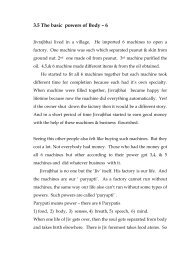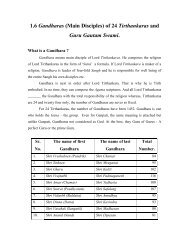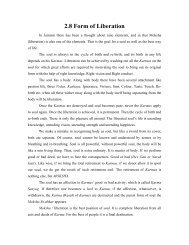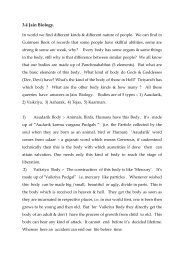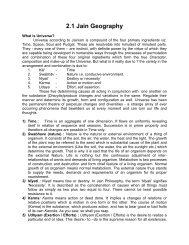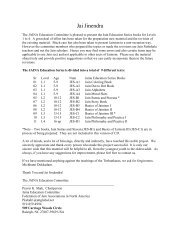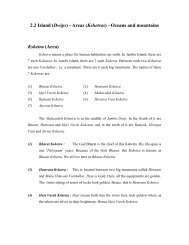âæ¢ ç¸ï¼¯ï¼ è£æ½® J - Jainism, Jain Religion - colleges
âæ¢ ç¸ï¼¯ï¼ è£æ½® J - Jainism, Jain Religion - colleges
âæ¢ ç¸ï¼¯ï¼ è£æ½® J - Jainism, Jain Religion - colleges
You also want an ePaper? Increase the reach of your titles
YUMPU automatically turns print PDFs into web optimized ePapers that Google loves.
WHO IS A TIRTHANKAR?<br />
In this universe, which is without a beginning or an end, the soul continues to experience sorrow and joy, traversing through<br />
numerous dimensions and forms including those of gods, animals, human beings, and hell-beings.<br />
The principle causes of these unending cycles of rebirth are the inherent attitudes of attachment and aversion, and their<br />
consequences. The attitudes of attachment and aversion, and their consequences. The attitudes of attachment and aversion<br />
result in the bondage of good and bad Karmas and as a consequence the soul continues its passage from one dimension<br />
to the other.<br />
Every soul is a dormant source of infinite energies, uninterrupted light of knowledge and unending joy and happiness. Knowledge<br />
and happiness are the<br />
„±üü<br />
fundamental natural<br />
¿¢¢Ý¢²<br />
activities of the soul. But<br />
½±¼é<br />
the accumulated inertia<br />
J<br />
of ignorance and illusion<br />
acts as an impediment to its endeavor to activate these inherent infinite energies. Even when it endeavor to activate these<br />
inherent infinite energies. Even when it launches its efforts, the dense accumulation of attitudes of attachment and aversion<br />
does not allow these efforts to become successful. As such, the disciplining of these attitudes of attachment and aversion<br />
becomes the prime need on this path of salvation.<br />
When its own true form is revealed on the soul it recognizes its inherent potential and gradually starts the efforts to win over<br />
the attitudes of fondness, attachment and aversion. This continuing endeavor to root out attachment and aversion is known<br />
as the path of discipline and equanimity. When the soul weakens the knots (Granthi) of attachment and aversion, as a result<br />
of its intense craving for salvation and practices of equanimity, penance, and meditation, it becomes tieless or Nirgranth (a<br />
term for <strong>Jain</strong> ascetic).<br />
Continuing its un-dogmatic practices or the Nirgranth attitude, a day comes when the soul destroys all attachment and<br />
aversion and conquers fondness. As a result of this victory the soul attains the statues of Jina.<br />
Jina means the victorious one.<br />
The individual who has destroyed attachment and aversion; who is absolutely free of fondness and ignorance; who has shed<br />
the four vitiating Karmas; namely illusory (Mohaniya), knowledge obstructing (Jnanavaraniya), perception obstructing<br />
(Darshanavaraniya), and power hindering (Antaraya); is known as Vicarage (the detached one), Jina (the victorious) and<br />
Sarvajna or Kevali (the omniscient).<br />
Any deserving soul may attain the status of Jina, omniscient, ultimate or pure soul (Param-Atma), but not a Tirthankar. This<br />
is because of the fact that it is only as the result of a specific pious type of Karma that one may become a Tirthankar.<br />
jainuniversity.org<br />
The lofty person, an omniscient Arihant, who defines, elaborates, and propagates Ahimsa, Truth, Brahmacharya etc., establishes<br />
the four pronged (Sadhu, Sadhvi, Shravak and Shravika) religious organization, and is endowed with unique powers is<br />
known as the Tirthankar.<br />
It is a belief, mentioned in <strong>Jain</strong> scriptures, that it is only the soul who earns the pious bond of the Tirthankar-nam-karma<br />
through a very high level of penance and meditation, can attain the status of a Tirthankar.<br />
During one descending cycle of time there may be innumerable omniscients but only twenty-four Tirthankars. Acharya<br />
Somdev Suri has given an explanation about why there can only be this specific number of Tirthankars-<br />
“If the number of things existing in nature is not a fixed figure why the numbers of things like date, day, constellations, stars,<br />
planets, oceans, mountains are believed to be fixed? It means that although they are numerous their exact number is fixed<br />
as per the law of nature”. During one descending cycle of time only these twenty-four Tirthankars are the originators of<br />
religion, founders of religious order and persons with divine powers.<br />
A Tirthankar is not an incarnation of the God. He is an ordinary soul that is born as a human and attains the states of a<br />
Tirthankar as a result of intense practices of penance, equanimity and meditation. As such, the Tirthankar is not defined as<br />
an Avatar (god-incarnate) but is the ultimate pure and developed state of the soul. Thus he may be called as the God in<br />
human form.<br />
In the current descending cycle there have been twenty-four Tirthankars from Bhagavan Rishabhdev to Bhagavan Mahavir.<br />
Their names are as follows-<br />
(1) Rishabhdev (2) Ajitnath (3) Sambhavnath (4) Abhinandan (5) Sumatinath (6) Padmaprabh (7) Suparshvanath (8)<br />
Chandraprabh (9) Suvidhinath (10) Sheetalnath (11) Shreyansnath (12) Vasupujya (13) Vimalnath (14) Anantnath (15)<br />
Dharmnath (16) Shantinath (17) Kunthunath (18) Arnath (19) Mallinath (20) Munisuvrat (21) Naminath (22) Arishtanemi (23)<br />
Parshvanath (24) Mahavir.<br />
Amar Muni - Tirthankar Charitra - Surana # 8<br />
www.jainuniversity.org




